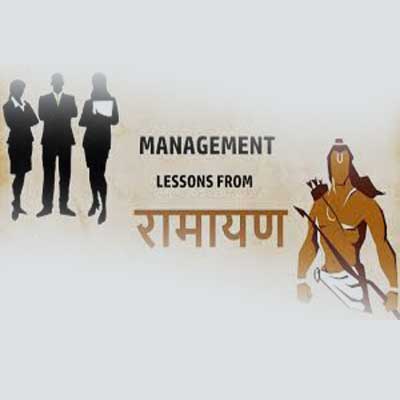KEY LEARNINGS FROM “RAMAYANA” | Aparna Sharma | Senior HR Professional & Certified Corporate Director I Editor’s Collection
 Ramayana stands as one of the most revered Hindu epic mythology with lots of learnings in every walk of life & sphere of work. A wise person won’t just look at Ramayana as a story but also as a medium of education. Over the years, sages and gurus have espoused the significance of doing our dharma (duty). Ramayana teaches us the lessons of leadership, governance, and management.
Ramayana stands as one of the most revered Hindu epic mythology with lots of learnings in every walk of life & sphere of work. A wise person won’t just look at Ramayana as a story but also as a medium of education. Over the years, sages and gurus have espoused the significance of doing our dharma (duty). Ramayana teaches us the lessons of leadership, governance, and management.
Here are 5 Key Business Lessons that we can learn from the Ramayana.
1. Nurturing Business Relations for Strategic Alliances –
If there was anyone in the Ramayana who had best of managerial characteristics, then it was Sughriv. He showed traits of a great manager by getting Rama to work consequently and getting back his kingdom.
His managerial skills are seen in other instances as well, especially when he had Angad to work for him. Imagine Sughriv to be a mediocre manager; Angad could have become one of their arch-rivals.
Lesson: A good manager proves time and again that businesses run on good relationships. And an ideal manager would value good relations with the employees, clients etc., to make it count for the organization. Lord Ram was one such master of fostering good relations.
2. Great Leaders Create More Leaders –
When Hanuman successfully discovered Sita’s whereabouts, he, in his own wisdom, set ablaze the city of Lanka. This decision of Hanuman disgruntled Rama. This led to Hanuman not taking further decisions on his own.
But being a great leader that Rama was, he removed himself from the scene where further decision making was involved. This was to let Hanuman revive his own decision-making capability.
Consider this scenario in the war where Ahiravan abducted Rama and Lakshmana with the intent to drag them to Patal Lok. It was Hanuman who had the right intellect and physical prowess to rescue them. Eventually, Hanuman succeeded in rescuing Rama and Lakshmana. What Rama did here is something that every leader needs to learn – creating more leaders within the organization to succeed in achieving a common goal.
Lesson: A true leader is one who creates leaders around. This is a very challenging task but when followed with caution, it will help in developing people within the organization who are capable of taking independent decisions for collective good.
3. Importance of Communication –
When something important is communicated, stick to it! We all know about the battle of Bali and demon Mayavee. One of their fights happened in the cave wherein Sughriv was ordered by Bali to stay out and keep a watch over the cave till the time he emerges back.
It was almost a year’s wait. And neither Bali nor the Mayavee demon came out. Sughriv ‘thought’ they must have killed each other in the battle. And therefore, he returned to Kishkindha (their kingdom) and took the ruler’s throne while also marrying Tara, Bali’s wife to be his.
Nevertheless, Bali returned later & seeing Sughriv as king and his wife as Sughriv’s wife, Bali felt betrayed.
Lesson: The root cause of fatal enmity between the two brothers – Sughriv and Bali had its root in awful miscommunication. A managerial lesson here is to beware of miscommunication at any point within the organization – be it in talent acquisition or in talent management.
4. Succession Planning –
The king of Ayodhya, Dasaratha’s plan to place Rama at the helm of affairs was interrupted by Kaikeyi. Surely, it was obvious to place Rama on the throne as his successor considering he was the elder one and that he was liked by all the people in the kingdom.
Referring to Raghuvansham of Kalidasa where Ramayana is extended to Luv-Kush, it is written that Rama divided the kingdom equally between Lava and Kusha.
Lesson: Successful companies are the ones who have great development plans for their top performers just like the succession plan for a kingdom. Essentially, a good leader will always choose to groom potential managers and employees to ensure long-term retention.
5. Efficient management lies in utilizing resources optimally –
 Rama represents a skillful manager, utilizing the available resources optimally to gain maximum out of minimum. These skills are evident even during the war with Ravana. The crucial one was the act of building a bridge over the sea to reach Lanka.
Rama represents a skillful manager, utilizing the available resources optimally to gain maximum out of minimum. These skills are evident even during the war with Ravana. The crucial one was the act of building a bridge over the sea to reach Lanka.
While there were a lot of thoughts on how to cross the Sea, Rama took 3 days for meditating and later on suggested to create a bridge. He picked up the right people for that job; two of his army men – Nal and Nila. They were skilled in making a bridge and constructing things. Rama also gathered local tribals (the Apemen), got them trained from his team to help Nal and Nila build the bridge at the earliest. The bridge was constructed within a few days and thereafter, helped Rama and his army to reach Lanka.
Lesson: Pick up the right people for the right task. A good management scenario is to have all the people giving their best. Rama had faith in Nal and Nila while assigning them the duty. Same goes for the modern day manager who delegates tasks among his/her team members (vests responsibility) with utmost faith in getting things done.
Drawing conclusions from this Epic –
• Form and lay a strategic vision and mission that serves the value system.
• A good leader is the one who orchestrates the entire conduction of an event that delivers expected results
• Break your big plans into small pieces based on periodic strategies and annual plan with reference to the target.
• Always evaluate your triumphs based on the available resources and its ownership to the immediate strategy.
Ramayana is one of such Indian Epics that has a vast potential to change our every-day human life. Be it in the management or in personal life, it never ceases to inspire us in small instances even after ages.


